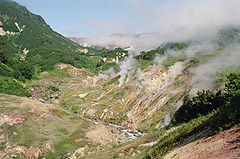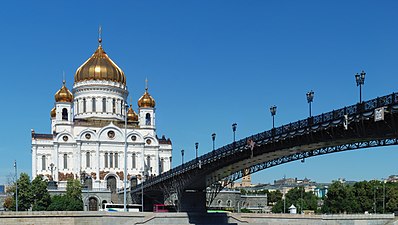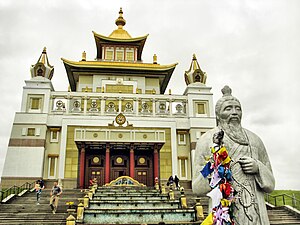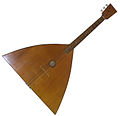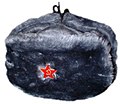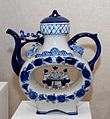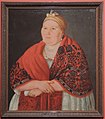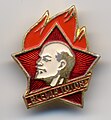Tourism in Russia
This article needs additional citations for verification. (April 2018) |
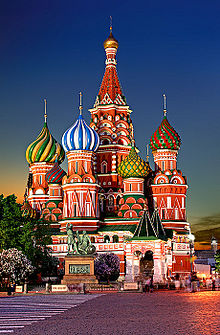
Tourism in Russia has seen rapid growth since the late Soviet times, first domestic tourism and then international tourism as well. Rich cultural heritage and natural variety place Russia among the most popular tourist destinations in the world. Not including Crimea, the country contains 23 UNESCO World Heritage Sites, while many more are on UNESCO's tentative lists.[1]
Major tourist routes in Russia include a travel around the Golden Ring of ancient cities, cruises on the big rivers including the Volga, and long journeys on the Trans-Siberian Railway. Diverse regions and ethnic cultures of Russia offer different foods and souvenirs, and show a great variety of traditions, including Russian Maslenitsa, Tatar Sabantuy, or Siberian shamanist rituals. In 2013, Russia was visited by 33 million tourists, making it the ninth-most visited country in the world and the seventh-most visited in Europe.[2]
After the 2022 Russian invasion of Ukraine, several governments, including the United States, France, the United Kingdom, Australia, and Canada have issued travel advisories calling on their nationals to avoid travel to Russia.[3]
Land and climate

Central European Russia (e.g. Moscow, Saint Petersburg, Nizhny Novgorod, Kazan, etc.) is in the same climate zone as the Baltic states, Belarus, and northern Ukraine. The climate of south-west Russia (the lower Volga, and the area between the Black Sea and the Caspian Sea) is more arid, with hotter summers and shorter winters. The climate of Russia's Far East along the Pacific coast is similar to that of Hokkaido, Japan and north-east China. The most severe climate is in Siberia where winters are very cold and summers are very hot, and in Russia's Far North where temperatures are always low, with the exception of Murmansk, where the sea never freezes due to the influence of the warm Norwegian Current. The climate of Russia's Black Sea coast is subtropical.[citation needed]
The climate of most popular tourist areas of Russia is similar to that of Eastern Europe. The mean temperatures of December, January and February in Moscow are −4 °C (25 °F), −7 °C (19 °F), −6 °C (21 °F) respectively, but colder weather is common. Over the past few decades spells of extremely cold weather (below −20 °C/-4 °F) in central European Russia have become rare (in the winter 2016/2017, Moscow had temperatures below −20 °C only for three days), while the number of wintry days when the temperature is close to or slightly above the freezing point has grown significantly. In coastal areas wintry temperatures can feel somewhat colder than they actually are due to high humidity.[citation needed]
Unless you are allergic to the pollen of certain trees and herbs (such as birch, horse chestnut, alder, lilac, cherry tree, ash tree, rowan tree, lime tree, or dandelion), the best time for travelling to central European Russia is late spring and early and mid autumn. Summer months are also good except for June in cities in central and south Russia when poplar fluff can be a nuisance. In central European Russia it usually begins to snow in late autumn. Central European Russia sometimes experiences cold spells in early May when the temperature can go from +15 °C/59 °F to the freezing point for a few days.[citation needed]
Tourism
Visa and Entry Requirements
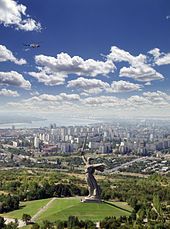
The citizens of CIS member states, most Latin American countries, Israel, and South Africa, can travel in Russia for 90 days without a visa; visitors from South Korea can visit Russia for 60 days without a visa; while tourists from Bosnia and Herzegovina, Cuba, Laos, Macau, Macedonia, Mongolia, Montenegro, Serbia, Seychelles and Thailand, can visit for 30 days without a visa.[citation needed] Free e-visas for visiting three regions in Russia's Far East (Primorye, Sakhalin, and Kamchatka) are available for tourists from China, Japan, India, Iran, Turkey, Morocco, Mexico, and some other countries.[citation needed]
Tourists from other countries are required to visit a Russian diplomatic mission to purchase a visa. Tourists are required to have a valid passport when crossing the Russian border. Russian visas cannot be purchased at the border.[citation needed] For more information see visa policy of Russia.
Cultural tourism


Popular tourist destinations in Russia are Saint Petersburg (which appeared in the list of top visited cities of Europe in 2010) and Moscow, the current and the former capitals of the country, recognized as World Cities. Moscow and Saint Petersburg museums such as Hermitage and Tretyakov Gallery, theaters including Bolshoi and Mariinsky, churches such as Saint Basil's Cathedral, Cathedral of Christ the Saviour, Saint Isaac's Cathedral and Church of the Savior on Blood, fortifications such as Moscow Kremlin and Peter and Paul Fortress, squares such as Red Square and Palace Square, and streets such as Tverskaya and Nevsky Prospect. Palaces and parks are found in the former imperial residences in the suburbs of Moscow (Kolomenskoye, Tsaritsyno) and Saint Petersburg (Peterhof, Strelna, Oranienbaum, Gatchina, Pavlovsk Palace, Tsarskoye Selo). Moscow contains a variety of Soviet-era buildings along with modern skyscrapers, while Saint Petersburg, nicknamed Venice of the North, boasts classical architecture, rivers, channels and bridges.[citation needed]

Nizhny Novgorod is the capital of the Volga region. It is considered to be "younger brother" of Moscow because it has its own Kremlin, the metro, the so-called "Nizhny Novgorod Arbat" (Bolshaya Pokrovskaya Street) and even a copy of the monument to Minin and Pozharsky, the original of which is in the Russian capital. Nizhny Novgorod is divided into two parts by the Oka River. The Upper City is its historical part. Here are the Kremlin, Minin and Pozharsky Square, Bolshaya Pokrovskaya and Rozhdestvenskaya streets, nightclubs, open spaces, a number of monuments and simply historical places. The Lower City is its industrial and commercial part. Here are the Fair, the old Sormovo and Kanavino, GAZ and Sotsgorod (the so-called "city in the city"), the railway terminal, the airport and attractions for people who want to see the styles of underground, industrial and grunge. The city is the main starting point for cruises along Volga River. From here begins shipping to Moscow and St. Petersburg.[citation needed]
Kazan, the capital of Tatarstan, shows a mix of Christian Russian and Muslim Tatar cultures. The city has registered a brand The Third Capital of Russia, though a number of other major Russian cities compete for this status, including Nizhny Novgorod, Novosibirsk, Yekaterinburg and Samara. Veliky Novgorod, Pskov, Dmitrov and the cities of Golden Ring (Vladimir, Yaroslavl, Kostroma and others) have at best preserved the architecture and the spirit of ancient and medieval Rus', and also are among tourist destinations. Many old fortifications (typically Kremlins), monasteries and churches are scattered throughout Russia, forming its unique landscape both in big cities and in remote areas.[citation needed]
Sakha Republic proposes to use former forced labour camps as a tourist attraction.[4] Poles visit places of Communist crimes, e.g., of the Katyn massacre and Solovetsky Islands.[5][6]
Museums
Russia is home to many museums. The most notable include the Tretyakov Gallery, the Kremlin Armoury and the State Historical Museum in Moscow, the Hermitage Museum, and the Russian Museum in St Petersburg, the Kazan Kremlin in Kazan, etc.[citation needed] Russia has many museums related to its literary and classical music heritage, such as Yasnaya Polyana associated with Leo Tolstoy, the Mikhaylovskoye Museum Reserve associated with Alexander Pushkin, the Dostoyevsky Museum, the Tchaikovsky State House-Museum. the Rimsky-Korsakov Apartment and Museum, the Mikhail Glinka Museum in Moscow, the Sergei Rachmaninoff Estate Museum in Ivanovka, Tambov Region, the Alexander Scriabin Apartment Museum in Moscow.[citation needed]
Museums related to Russia's military history and military hardware include the Central Museum of the Great Patriotic War on Poklonnaya Hill, the Central Museum of the Armed Forces of Russia in Moscow, the Central Museum of the Russian Air Force in Monino, Moscow Region, the Central Naval Museum in St Petersburg, the Battle of Stalingrad Museum in Volgograd.[citation needed]
Museums related to science and technology include the Polytechnic Museum of Moscow, the Memorial Museum of Cosmonautics, the Museum of the Energia Rocket and Space Corporation in Korolev, Moscow Region.
Nature tourism
In Russia, Nature Reserves have long history and it has its own word of definition Zapovedniks (Russian: заповедник, plural заповедники, ) more than 100 Nature Reserves exist in Russia and more than 50 National Parks it has a great attraction to tourists. several of them are among World Heritage Sites. The most famous national parks and sanctuaries of Russia include the Baikal Nature Reserve , the Altai Nature Reserve, the Lazovsky Nature Reserve, the Kedrovaya Pad Nature Reserve, the Curonian Spit National Park, the Valdaysky National Park, the Baikal-Lena Nature Reserve, the Ilmen Nature Reserve. The Seven Wonders of Russia, the most popular tourist destinations chosen in a national vote in 2008, include Lake Baikal, Valley of Geysers, Manpupuner rock formations, and Mount Elbrus. Other areas interesting for tourists include Kamchatka with its volcanoes and geysers, Karelia where many lakes and granite rocks are found, including, Tyva with its wild steppes, Republic of Adygea where Fisht Mountain is located, Chechnya Republic where Lake Kezenoyam is located.[7]
Health tourism

Several mineral spa resorts have been established across Russia throughout the ages. The most renown regions are Kamchatka Krai, Altai Krai, Krasnodar Krai, Stavropol Krai, North Caucasus region of Russia.[8] Numerous cites enjoy natural hot spring water during winter and some of Russian cities are called Russian Spa town, including Pyatigorsk, Yessentuki, Kislovodsk, Zheleznovodsk and Mineralnye Vody; these towns are jointly known as the Caucasian Mineral Waters.
Russia has one of the largest water borders in world, but only the more Southern regions are suitable for resort tourism. The warm subtropical Black Sea coast of Russia is the site for a number of seaside resorts such as Sochi and Tuapse, known for their shale beaches and the nature of the Caucasus Mountains.[citation needed]
Winter sport
A vast part of Russian territory is in Subarctic climate and humid continental climate, and that is why it is cold. In addition, Russia is mountainous in regions like Northern Caucasus, Altai Krai and Kamchatka Peninsula. The Highest peak in Europe, Mount Elbrus, is in Russia, which makes Russia a place for Winter sport. Ski resorts are common in Russia and 2014 Winter Olympics is the resemblance of how ski resorts has been developed in Russia. A famous ski resort in Russia is Sochi and its Krasnaya Polyana. Other ski resorts in Russia are Dombay in Karachay–Cherkessia in Northern Caucasus.[citation needed]
Medical tourism
Russia is a destination for medical tourism. A large factor in its continued popularity is the relatively weak ruble post-2014, which saw the industry grow rapidly from some 110 thousand clients in 2017[9] to some 728 thousand clients in the first five months of 2020.[10] Stomatology is the most popular (44% of patients), genecology and urology follow (25% taken together), the other popular services are plastic surgery (10%), ophthalmology (10%), and cardiology (5%).[9] Most clients come from the CIS states, where receiving high-tech medical assistance can be problematic, particularly from Central Asia, which amounts for 62% of all patients; but also from Eastern Europe (32%), South and East Asia (5%).[11] In addition to price and accessibility of complex manipulations, the difference in regulations between Russia and the clients' own nations is a driving factor for receiving care in Russia: for instance, in vitro fertilization is illegal in China, but legal in Russia.[10]
Religious tourism
Religious tourism has two main subtypes: pilgrimage, as travel done for religious or spiritual purposes, and the viewing of religious monuments and artefacts, as a kind of sightseeing. The former is relatively insignificant for the Russian tourism industry, amounting for approximately 100 thousands pilgrims yearly.[12] The latter is much more important, places of worship gracing the tourist centers of most Russian cities, or specifically visited even by secular tourists in their remote locations.[citation needed]
Orthodox Christianity being by far the most common religion in Russia, it also accounts for most religious monuments across the country. Multiple Orthodox Christian churches and cathedrals are part of the UNESCO World Heritage Site list.[citation needed]
-
Domes of Sobornaya Square in Moscow Kremlin
-
The Valaam Monastery
Muslim peoples have been a part of the Russian state for half a millennium, which means multiple pieces of Islamic religious architectural art are scattered across the country, from mosques to maqāms. They are mostly clustered in the historically Muslim regions, but some can be found in most major cities.[citation needed]
-
The Kul Sharif Mosque in Kazan
-
Lala Tulpan in Ufa
-
The Juma Mosque in Derbent, the oldest in Russia, built 736
Russia has a significant Buddhist minority, including the Buryats traditionally living near Lake Baikal, the Tuvans, as well as the Kalmyks.[citation needed]
-
The Datsan Gunzechoinei in St.Petersburg
-
The Burkhan Bakshin Altan Sume in Elista
-
Ivolginsky Datsan in Buryatia
Major national holidays and celebrations
for a full list see Public holidays in Russia
- Novy God (New Year's Eve), 31 December
- Orthodox Christmas, 7 January
- Maslenitsa, in February or March, in the week before the Lent (according to the Julian calendar)
- Easter, in spring after the Lent (according to the Julian calendar)
- Victory Day, 9 May
- Russia Day, 12 June
- Kupala Night, 7 July
- Day of Christianization of Kievan Rus', 28 July
- Navy Day (Russia), the last Sunday of July (celebrations include naval parades in Saint Petersburg and Vladivostok)
- Unity Day (Russia), 4 November
- Defender of the Fatherland Day, 23 February
Major events
- KHL Conference Finals and the Gagarin Cup, March and April, final series of the Kontinental Hockey League
- Kinotavr, June, an international film festival in Sochi
- Scarlet Sails Festival, on a Saturday in the second half of June, annual celebration in St Petersburg marking the end of school year
- International Tchaikovsky Competition, 10–30 June, an annual international competition in Moscow, final gala concerts 2–3 July in Moscow and St Petersburg
- Russian Super Cup, July
- MAKS (air show), July, an annual international aerospace show in Zhukovsky, Moscow Region
- Silk Way Rally, July
- Battle on the Neva, July, an international history festival in St Petersburg featuring historical medieval battles (HMB)
- GUM Gorkyclassic Motor Rally,[13] July, an annual motor rally and car parade featuring classic cars in Moscow
- Sabantui, on a Sunday in summer, a major holiday celebrated primarily in Tatarstan and Bashkortostan
- Spasskaya Tower Military Music Festival and Tattoo, the last week of August, the first week of September, an annual international military music festival in Red Square, Moscow
- Eid al-Fitr, 1st day of the month of Shawwal in the Islamic Calendar, in order to mark the end of the holy month of Ramadan
- Eid al-Adha, 10th day of the last month of Dhul-Hijjah in the Islamic calendar, locally known as Kurban Bairam, celebrated primarily in Tatarstan, Bashkortostan, North Caucasus and by Muslim communities in major cities
- Moscow International Film Festival, an international biennial film festival in Moscow
- City Day in Moscow, first Saturday of September, an annual celebration marking the birthday of Moscow
- Borodino Day, first Sunday of September, an annual event in memory of the Battle of Borodino, includes historical re-enactment, in Borodino, Moscow Region
- The Moscow Biennale, dates vary, a biennial contemporary art festival that started in 2003
Souvenirs and food
Typical souvenirs include the Matryoshka doll and other handicraft, samovars for water heating, ushanka and papaha warm hats, and fur clothes. Russian vodka and caviar are among the food that attracts foreigners, along with honey, blini, pelmeni, shchi soup and other products and dishes of Russian cuisine.
-
Syrok (cottage cheese covered in chocolate)
-
Soviet-era souvenirs
Regions and localities associated with specific souvenirs and products
- Caviar: Primorye Territory; Sakhalin; Kamchatka
- Honey: Bashkortostan; Altai Territory; Krasnodar Territory
- Pryaniki: Tula; Arkhangelsk; Vyazma, Smolensk Region; Pokrov, Vladimir Region; Gorodets, Nizhny Novgorod Region
- Chocolate: Moscow; Pokrov, Vladimir Region
- Amber: Kaliningrad
- Diamonds: Yakutsk
- Glass souvenirs: St Petersburg; Moscow; Gus-Khrustalny, Vladimir Region
- Gems: Nizhny Tagil; Yekaterinburg
- Beresta (birch bark) souvenirs: Arkhangelsk; Semyonov, Nizhny Novgorod Region
- Metalwork: Tula; Zhostovo, Ivanovo Region
- Wooden souvenirs and pottery: Gorodets, Nizhny Novgorod Region; Palekh, Ivanovo Region; Gzhel, Moscow Region; Dymkovo District of Kirov; Filimonovo, Tula Region; Semyonov, Nizhny Novgorod Region
- Textiles: Ivanovo; Yaroslavl
- Wool products: Moscow; Pavlovsky Posad, Moscow Region; Orenburg
- Lace: Vologda; Yelets, Lipetsk Region
- Valenki and felt products: Yaroslavl; Yelets, Lipetsk Region; Ivanovo
- Furs: Pyatigorsk; Kazan; Ulyanovsk; Tver
- Wristwatches and clocks: Moscow; Chelyabinsk
Transport
For security reasons, Russian ticket offices sell tickets for trains, airplanes and coaches only if you show your passport.[14]
Railways

The state-owned company Russian Railways (abbreviated as РЖД) operates most of rail services across the country and is crucial for the rail transport in Russia. High-speed rail services are available between Moscow and St Petersburg, between Moscow and Nizhny Novgorod, and between St Petersburg and Helsinki (Finland). European Russia and the Russian Far East are connected by rail via the Trans-Siberian Railway. A train trip from Moscow to Vladivostok takes 6 days.[15] Russia uses the 1,524mm (5ft) track gauge, which is also shared by all the former Soviet republics (Estonia, Latvia, Lithuania, Belarus, Ukraine, Georgia, Armenia, Azerbaijan, Kazakhstan, Turkmenistan, Tajikistan, Uzbekistan, Kyrgyzstan), Mongolia, and is practically identical with the rail gauge of Finland. Trains crossing the border between Russia (Belarus, Ukraine) and EU member states (except the Baltic states and Finland) or between Russia and China, stop at special crossing points where each carriage is lifted for its bogies to be changed. Trains remain at crossing points for up to 2 hours.[16]
Sea and river transport

Russia's major sea ports include St Petersburg and Kaliningrad on the Baltic coast; Murmansk and Arkhangelsk on the Arctic coast; Vladivostok, Yuzhno-Sakhalinsk, and Petropavlovsk-Kamchatsky on the Pacific coast; Sochi, Novorossiysk, and Sevastopol on the Black Sea coast; Astrakhan on the Caspian coast. In European Russia, many river boat companies offer journeys to cities and towns on the Volga River, its tributaries and connected canals: Moscow (via the Moscow Canal), Yaroslavl, Kostroma, Nizhny Novgorod, Kazan, Saratov, Volgograd, Astrakhan. River boats from St Petersburg can travel to Staraya Ladoga and Veliky Novgorod on the Volkhov River, to Ladoga Lake, and to Moscow (via canals).[17]
Air transport
Due to the 2022 Russian invasion of Ukraine, the airspace of the EU, Switzerland, the UK, Canada, the US, and several other countries were closed to all Russian aircraft and flights.[3] Also, a number of airlines cancelled flights into and out of Russia. In addition, airspace around southern Russia is restricted, and a number of airports in the area closed.[18]
Russia's busiest international airports are situated near Moscow, St Petersburg, Volgograd, Kazan, Krasnodar, Sochi, and Vladivostok. For more information see a list of airports in Russia. Moscow and Saint Petersburg had prior to the invasion been served by direct flights from most European capitals, and Moscow also had direct flights from many cities in East Asia, South Asia, Africa, the Middle East, and North America.[19] Countries that have no direct flights to Russia include Australia,[20] Canada[21] and Ukraine.[22]
Roads
Major national thoroughfares are known as federal highways. For more information see Russian federal highways. Most of highways are toll-free, however recently there have opened a few toll roads.[23] Usual roads in smaller Russian cities and in the countryside can be in bad condition.[24] During the cold season (from November till April), when there is permanent snowpack and ice on the roads, winter tyres are mandatory.[25]
Public transport in major cities

Russian cities that have a metro include Moscow, St Petersburg, Nizhny Novgorod, Novosibirsk, Samara, Yekaterinburg, Kazan.[26] Entrances to metro stations are marked using the letter M which looks the same in the Russian and Roman alphabets. On the Moscow Metro, announcements on trains are made in Russian and English, and direction signs and maps often include English.[27] Apart from buses and trams, trolleybuses are a very common means of overground transport in Russian cities. For more information see the list of trolleybus systems in Russia. Another widely used means of public transport is marshrutkas, or shared taxies. If you are going to visit Moscow and use public transport, see the article about the Troika card (a similar card known as Podorozhnik is used in St Petersburg). Taxi services available in major Russian cities include Yandex, Uber (operated by Yandex.Taxi), and Gett.
Safety
Natural disasters
Natural hazards of central European Russia include hurricanes, thunderstorms, and spring floods when snowpack accumulated during the winter melts away; south Russia sometimes experiences flash floods. Earthquakes only occur in Russia in mountainous areas in the south (the Caucasus Mountains, the Altai Mountains) and the Pacific coast. Forest fires can occur in hot summers, especially in south Siberia.[citation needed]
Dangerous animals
Big wild animals such as bears and wolves are common in wooded areas of Siberia and Russia's Far East. They also inhabit some remote thick forests in north-east European Russia. Female bears can be especially dangerous when they have cubs, while male bears are especially dangerous if they wake up and roam in wintertime; wolves are dangerous in the winter period. The only poisonous snake in central European Russia is the viper; it mainly inhabits boggy and marshy forests but can occasionally be met in other types of forests, so high boots are advisable for forest trips and hikes. Tick-borne encephalitis is another hazard that is associated with forests and parks in Russia. Animals that are most prone to rabies are stray dogs and cats, wild foxes, wolves, hedgehogs, raccoon dogs.
Environmental contamination
A certain level of radioactive contamination caused by rains following the Chernobyl disaster is found in some parts of Bryansk Region and Tula Region. High levels of industrial contamination are found in the city of Norilsk and in Chelyabinsk Region and Sverdlovsk Region.[citation needed]
Socio-cultural concerns
Public safety
According to travel advice by the UK government, "most visits to Russia are trouble-free, but petty crime does happen".[28]
Nearly 20,000 people in Russia were killed as a result of crimes in January-October 2021, according to the Russian Interior Ministry.[29]
In June 2022, the US State Department advised citizens not to travel to the North Caucasus, including Chechnya and Mount Elbrus, due to terrorism, kidnapping, and risk of civil unrest.[18]
Militant groups
Most regions of Russia are safe. However, travels to some areas in North Caucasus can pose a certain risk, especially parts of Chechnya and Dagestan.[citation needed]
Foreign travel statistics
In 2013, 27 million international tourists arrived in Russia, generating US$11.2 billion in international tourism revenue for the country.[30][failed verification] Including domestic and international tourism, the industry directly contributed RUB860 billion to the Russian GDP and supported 966,500 jobs in the country.[31]
See also
- Visa policy of Russia
- Russian culture
- List of museums in Russia
- List of World Heritage Sites in Russia
- Wildlife of Russia
References
- ^ "UNESCO World Heritage Centre – Tentative Lists". UNESCO. Retrieved 16 December 2017.
- ^ "Tourism Highlights 2014" (PDF). E-unwto.org. Archived from the original (PDF) on 12 January 2015. Retrieved 16 December 2017.
- ^ a b "Europe: Russia extends flight suspension at multiple southern and central airports until April 19 /update 40". Europe: Russia extends flight suspension at multiple southern and central airports until April 19 /update 40 | Crisis24.
- ^ Luhn, Alec (26 March 2014). "Russia's Sakha Republic proposes 'tourist camps' on former gulag sites". The Guardian.
- ^ "Strona domeny katyn.pl". Katyn.pl. Archived from the original on 14 April 2016. Retrieved 16 December 2017.
- ^ Itaka, Biuro Podróży. "Tajemnice Wysp Sołowieckich – ITAKA". Itaka.pl. Retrieved 16 December 2017.
- ^ "40 most beautiful places in Russia". Russianblogger.me. Retrieved 30 September 2015.
- ^ "Hit the spa Russian style: Mineral springs and hot tub substitutes". 2 March 2016.
- ^ a b "Медицинский туризм: почему иностранцы лечатся в России, а россияне — за границей" [Medical tourism: why foreigners seek treatment in Russia, and Russians abroad]. forbes.ru (in Russian). Retrieved 15 August 2021.
- ^ a b "Какое лечение в России выбирают иностранцы" [What kind of medical treatment do foreigners choose in Russia]. ratanews.ru (in Russian). RATA news. Retrieved 15 August 2021.
- ^ Daykhes, Arkady N.; Jakovljevic, Mihajlo; Reshetnikov, Vladimir A.; Kozlov, Vasily V. (2020). "Promises and Hurdles of Medical Tourism Development in the Russian Federation". Frontiers in Psychology. 11: 1380. doi:10.3389/fpsyg.2020.01380. PMC 7324547. PMID 32655455.
- ^ "Туристов отделят от паломников с 1 ноября" [Starting November 1, tourists will be separated from pilgrims]. atorus.ru (in Russian). Ассоциация Туроператоров. Retrieved 15 August 2021.
- ^ "Legendary Soviet cars on parade at Moscow's GUM Motor Rally Gorkyclassic 2017". The Telegraph. 24 July 2017.
- ^ "Travel by Train 101: Everything You Need to Know About Travelling by Train in Russia". Trainsrussia.com. Retrieved 16 December 2017.
- ^ "Moscow Vladivostok train tickets at discount prices. Rossiya train. Free Schedules and Timetables. Take the Trans Siberian Express with us today and save". Transsiberianexpress.net. Retrieved 16 December 2017.
- ^ "Faster through railway border crossing – Visit Belarus!". Visitbelarus.eu. Archived from the original on 11 October 2017. Retrieved 16 December 2017.
- ^ "Russian River Cruises & Tours 2017, Best River Trips & Cruises to Russia (St Petersburg)". Russian-river-cruises.com. Retrieved 16 December 2017.
- ^ a b "Russia Travel Advisory". travel.state.gov.
- ^ "Russia – Travel guide at Wikivoyage". En.wikivoyage.org. Retrieved 16 December 2017.
- ^ "Found the cheapest flights to Russia". Skyscanner.com.au. Retrieved 16 December 2017.
- ^ "Aeroflot Cancels Flights To Canada". HuffPost. 3 October 2014. Retrieved 16 December 2017.
- ^ Rainsford, Sarah (24 October 2015). "Russia and Ukraine to ban direct flights". BBC. Retrieved 16 December 2017.
- ^ "Russia 2018 – Fan guide – Free and toll roads". Welcome2018.com. Retrieved 16 December 2017.
- ^ "World Highways - Concern for Russia's poor road quality". Archived from the original on 15 September 2017. Retrieved 11 October 2017.
- ^ "Winter Tyre Laws". Continental-tires.com. Retrieved 16 December 2017.
- ^ "Metro Systems in RUSSIA – Metro systems of the World". Retrieved 16 December 2017.
- ^ "All metro stops in Moscow now announced in Russian and English / News / Moscow City Web Site". Mos.ru. 27 April 2017. Retrieved 16 December 2017.
- ^ "Safety and security - Russia travel advice".
- ^ "Almost 20,000 people killed as result of crimes in Russia in 2021 — ministry".
- ^ "Tourism Highlights 2013 edition" (PDF). Dtxtq4w60xqpw.cloudfront.net. Archived from the original (PDF) on 27 November 2013. Retrieved 27 November 2013.
- ^ "2013 Travel & Tourism Economic Impact Report Russian Federation" (PDF). Wttc.org. Archived from the original (PDF) on 2 December 2013. Retrieved 27 November 2013.
External links
- Moscow City Guide at the official website of the Mayor of Moscow
- St Petersburg Official City Guide
- Karelia Tourist Portal (Solovetsky Islands, Kizhi)
- Guide to the Golden Ring of Russia
- Tatarstan Official Guide(including Kazan)
- Official Rosa Khutor Guide (ski resorts in Sochi)
- Baikal Tourist Guide
- Vladivostok City Guide
- Russia Travel Guide
- Russia travel and tourism at Curlie
- Fully Personalized Itineraries for independent travel in Russia
- Representing in North America: Russian National Tourist Office
- (in Russian) Federal Agency for Tourism
- Russia Beyond the Headlines news portal
- Cheboksary tourist portal Archived 13 August 2018 at the Wayback Machine





